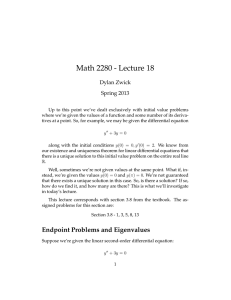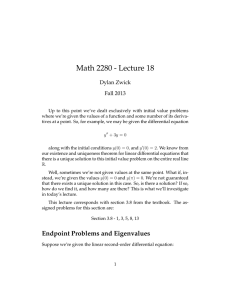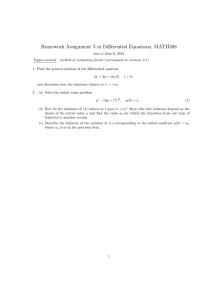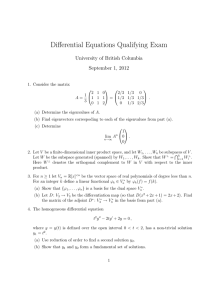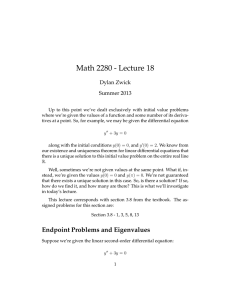Math 2280 - Lecture 18 Dylan Zwick Spring 2013
advertisement
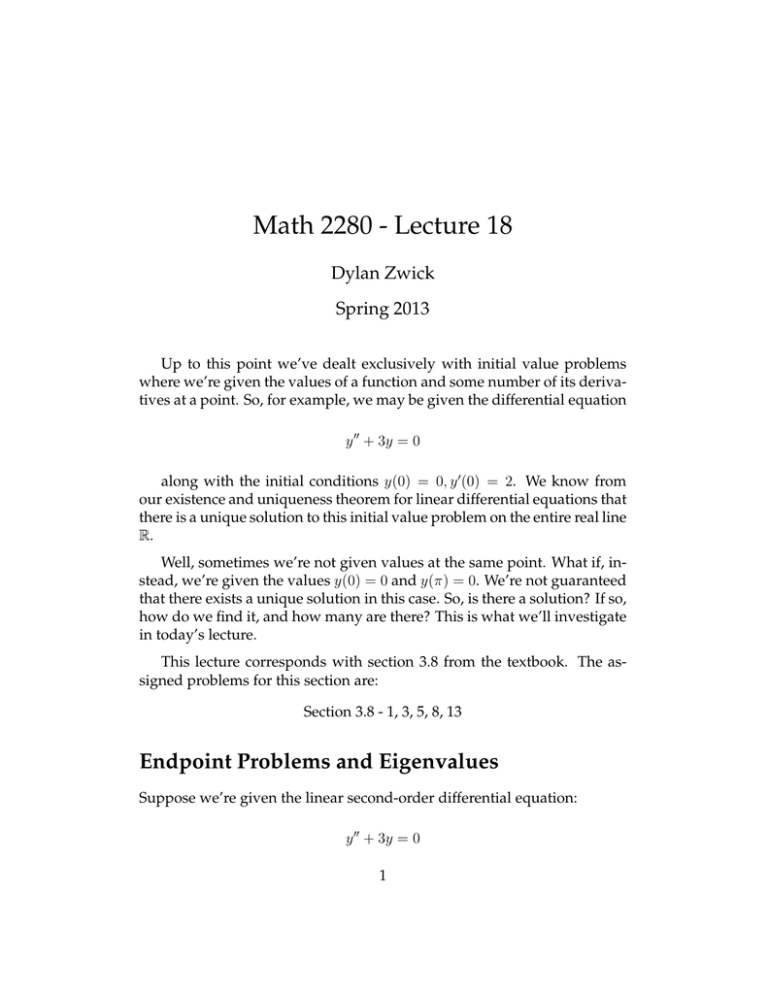
Math 2280 - Lecture 18 Dylan Zwick Spring 2013 Up to this point we’ve dealt exclusively with initial value problems where we’re given the values of a function and some number of its derivatives at a point. So, for example, we may be given the differential equation y ′′ + 3y = 0 along with the initial conditions y(0) = 0, y ′(0) = 2. We know from our existence and uniqueness theorem for linear differential equations that there is a unique solution to this initial value problem on the entire real line R. Well, sometimes we’re not given values at the same point. What if, instead, we’re given the values y(0) = 0 and y(π) = 0. We’re not guaranteed that there exists a unique solution in this case. So, is there a solution? If so, how do we find it, and how many are there? This is what we’ll investigate in today’s lecture. This lecture corresponds with section 3.8 from the textbook. The assigned problems for this section are: Section 3.8 - 1, 3, 5, 8, 13 Endpoint Problems and Eigenvalues Suppose we’re given the linear second-order differential equation: y ′′ + 3y = 0 1 with the specified values y(0) = 0, y(π) = 0. This type of problem is sometimes called an “endpoint value problem”, as instead of specifying initial conditions, we’ve specified the value of the function at the “endpoints” 0 and π. Well, the general solution to this differential equation is: √ √ y(x) = A cos 3x + B sin 3x. If we plug in the first endpoint value, x = 0, we get y(0) = A = 0. Setting A = 0 if we plug in our second endpoint value, x = π, we get y(π) = B sin √ 3π. √ Now, sin 3π ≈ −.7458, which is important only in that it is not zero. So, this means B = 0, and the only solution to this endpoint value problem is the trivial solution y(x) = 0. OK, so there is a unique solution in this case. It just happens to be the trivial one. Let’s modify this differential equation slightly. We’ll still have the same endpoint values, y(0) = y(π) = 0, but we’ll change the differential equation to: y ′′ + 4y = 0. Doesn’t seem all that different, does it? Well, it is. The general solution to this differential equation is: y(x) = A cos 2x + B sin 2x. If we plug in y(0) = A = 0 we don’t get anything new, and we end up with the equation: 2 y(x) = B sin 2x. But, if we plug in x = π we have y(π) = B sin 2π = 0. Now, sin 2π = 0, so this means any value for B will satisfy the differential equation and the endpoint values. There are an infinite number of solutions. This will be the general scenario for this type of differential equation. There will either be only the trivial solution, or an infinite number of solutions, and which one we get will depend upon a parameter in the differential equation. In general, suppose we have a differential equation of the form: y ′′ + p(x)y ′ + λq(x)y = 0 with endpoint values y(0) = 0, y(L) = 0. Well, there will either be only the trivial solution, or there will be an infinite number of solutions, and which one we get will depend upon the parameter λ. The values of λ for which we get an infinite number of solutions are called the eigenvalues of the differential equation. The associated solutions are called the eigenfunctions. 3 Example - Determine the eigenvalues and associated eigenfunctions for the endpoint problem y ′′ + λy = 0 y(0) = 0, y(L) = 0. 4 Note that for a given eigenvalue there will be many eigenfunctions, but in general the eigenfunctions for a given eigenvalue will all be linearly dependent. (They’ll all be constant multiples of each other.) There are exceptions to this, but we won’t deal with them now. The term eigenvalue should sound familiar to you if you’ve taken a linear algebra course. In particular, for a square matrix A a number λ is an eigenvalue if there exists a vector x 6= 0 such that Ax = λx. This will be true if and only if the matrix A − λI is singular. Which is the case if and only if its determinant is 0. So, why do we call those values in our differential equations eigenvalues? Well, let’s take a look at our second-order system again: y ′′ + p(x)y ′ + λq(x)y = 0. We know there will be a unique general solution to this system, and this general solution will depend upon the parameter λ. So, we can write this general solution as: y(x) = Ay1 (x, λ) + By2 (x, λ). Now, if we’re given endpoint values y(0) = 0 and y(L) = 0 then we need to find values for A and B that satisfy the system of equations: y1 (0, λ) y2 (0, λ) y1 (L, λ) y2 (L, λ) A B = 0 0 . This system of equations has a non-trivial solution (the trivial solution being A = B = 0) if and only if y1 (0, λ) y2 (0, λ) y1 (L, λ) y2 (L, λ) 5 = 0. The values of λ for which this is true are the eigenvalues of our differential equation. Just as in linear algebra, they’re the values for which a given determinant is 0. Example - The eigenvalues of the following endpoint value problem are all nonnegative. First determine whether λ = 0 is an eigenvalue, then find all positive eigenvalues and associated eigenfunctions. y ′′ + λy = 0; y ′ (0) = 0, y ′(π) = 0. 6
